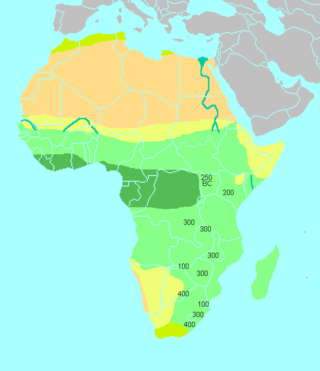Related Research Articles

The Bantu languages are a language family of about 600 languages that are spoken by the Bantu peoples of Central, Southern, Eastern and Southeast Africa. They form the largest branch of the Southern Bantoid languages.

Niger–Congo is a hypothetical language family spoken over the majority of sub-Saharan Africa. It unites the Mande languages, the Atlantic-Congo languages, and possibly several smaller groups of languages that are difficult to classify. If valid, Niger-Congo would be the world's largest in terms of member languages, the third-largest in terms of speakers, and Africa's largest in terms of geographical area. It is generally considered to be the world's largest language family in terms of the number of distinct languages, just ahead of Austronesian, although this is complicated by the ambiguity about what constitutes a distinct language; the number of named Niger–Congo languages listed by Ethnologue is 1,540.

Swahili, also known by its local name Kiswahili, is the native language of the Swahili people, who are found primarily in Kenya, Tanzania and Mozambique. It is a Bantu language, though Swahili has borrowed a number of words from foreign languages, particularly Arabic and Persian, but also words from Portuguese, English and German. Around forty percent of Swahili vocabulary consists of Arabic loanwords, including the name of the language. The loanwords date from the era of contact between Arab traders and the Bantu inhabitants of the east coast of Africa, which was also the time period when Swahili emerged as a lingua franca in the region. The number of Swahili speakers, be they native or second-language speakers, is estimated to be around 80 million.

OK is an English word denoting approval, acceptance, agreement, assent, acknowledgment, or a sign of indifference. OK is frequently used as a loanword in other languages. It has been described as the most frequently spoken or written word on the planet.

Sir Edward Evan Evans-Pritchard FBA FRAI was an English anthropologist who was instrumental in the development of social anthropology. He was Professor of Social Anthropology at the University of Oxford from 1946 to 1970.

The Bantu expansion is a hypothesis about the history of the major series of migrations of the original Proto-Bantu-speaking group, which spread from an original nucleus around Central Africa across much of sub-Saharan Africa. In the process, the Proto-Bantu-speaking settlers displaced or absorbed pre-existing hunter-gatherer and pastoralist groups that they encountered.

The Ik people are an ethnic group in northeastern Uganda near the border with Kenya. The group is unarmed and habitually peaceful, numbering approximately 13,939 people. They have experienced and been affected by various human rights violations, including forced evictions and/or exclusions from ancestral lands and natural resources, with 70% of the land lost to conservation initiatives, as well as violence and destruction of property, which result in continued impoverishment, social and political exploitation and marginalisation.
Kisuba, also known as Olusuba, is a Bantu language spoken by the Suba people of Kenya. The language features an extensive noun-classification system using prefixes that address gender and number. Suba clans are located on the eastern shore and islands of Lake Victoria in Kenya and Tanzania. They have formed alliances with neighboring clans, such as the Luo people, via intermarriages, and as a result a majority of Suba people are bilingual in Dholuo. The Suba religion has an ancient polytheistic history that includes writings of diverse, ancestral spirits. A recent revival of the Suba language and its culture has influenced the increasing number of native speakers each year.
Kwavi is the dialect of Maasai spoken by the Kwavi people of Tanzania. According to Hurskainen (1994), "The Parakuyo are a Maa-speaking ethnic group scattered over a large area in the northeastern and central parts of Tanzania", while Beidelman (1960) confirms that "Kwavi" and "Baraguyu" are synonymous.

Culture of Uganda is made up of a diverse range of ethnic groups. Lake Kyoga forms the northern boundary for the Bantu-speaking people, who dominate much of East, Central, and Southern Africa. In Uganda, they include the Baganda and several other tribes

The Zaramo people, also referred to as Dzalamo or Saramo, are a Bantu ethnic group native to the central coast of Tanzania, particularly Dar es Salaam Region and Pwani Region. They are the largest ethnic group in and around Dar es Salaam, the former capital of Tanzania and the 7th largest city in Africa. Estimated to be about 0.7 million people, over 98% of them are Muslims, more specifically the Shafi'i school of Sunni Islam. Their culture and history have been shaped by their dwelling in both urban and rural landscapes.
The Kaguru, or Kagulu, are a Bantu ethno-linguistic group based in central Tanzania. The population of Kaguru was predicted to be 217,000 in 1987.

The Ha, also called or Abaha, are a Bantu ethnic group found in Kigoma Region in northwestern Tanzania bordering Lake Tanganyika. In 2001, the Ha population was estimated to number between 1 and 1.5 million, making them one of the largest ethnic groups in ethnically diverse Tanzania.
Semi-Bantu or Semibantu is a used for specific inhabitants of the Western grassfields of Cameroon, who speak languages that have certain characteristics to the Bantu language family, but they're excluded from them. The people themselves are considered ethnically and linguistically divergent from other Bantu peoples of central and southern Africa.
John Francis Marchment Middleton was a British professor of anthropology in the United States, specializing in Africa. He was director of the International African Institute in 1973-74 and in 1980–81. His work on the Lugbara religion is considered a classic of African anthropology.
The Northeast Coast Bantu languages are the Bantu languages spoken along the coast of Tanzania and Kenya, and including inland Tanzania as far as Dodoma. In Guthrie's geographic classification, they fall within Bantu zones G and E.
Sukuma is a Bantu language of Tanzania, spoken in an area southeast of Lake Victoria between Mwanza, Shinyanga, and Lake Eyasi.
Eton, or Ìtón, is a Bantu language spoken by the Eton people of Cameroon.

The Bantu peoples, or Bantu, are an ethnolinguistic grouping of approximately 400 distinct ethnic groups who speak Bantu languages. They are native to 24 countries spread over a vast area from Central Africa to Southeast Africa and into Southern Africa. There are several hundred Bantu languages. Depending on the definition of "language" or "dialect", it is estimated that there are between 440 and 680 distinct languages. The total number of speakers is in the hundreds of millions, ranging at roughly 350 million in the mid-2010s. About 60 million speakers (2015), divided into some 200 ethnic or tribal groups, are found in the Democratic Republic of the Congo alone.
References
- ↑ Kaguru at Ethnologue (18th ed., 2015) (subscription required)
- ↑ Jouni Filip Maho, 2009. New Updated Guthrie List Online